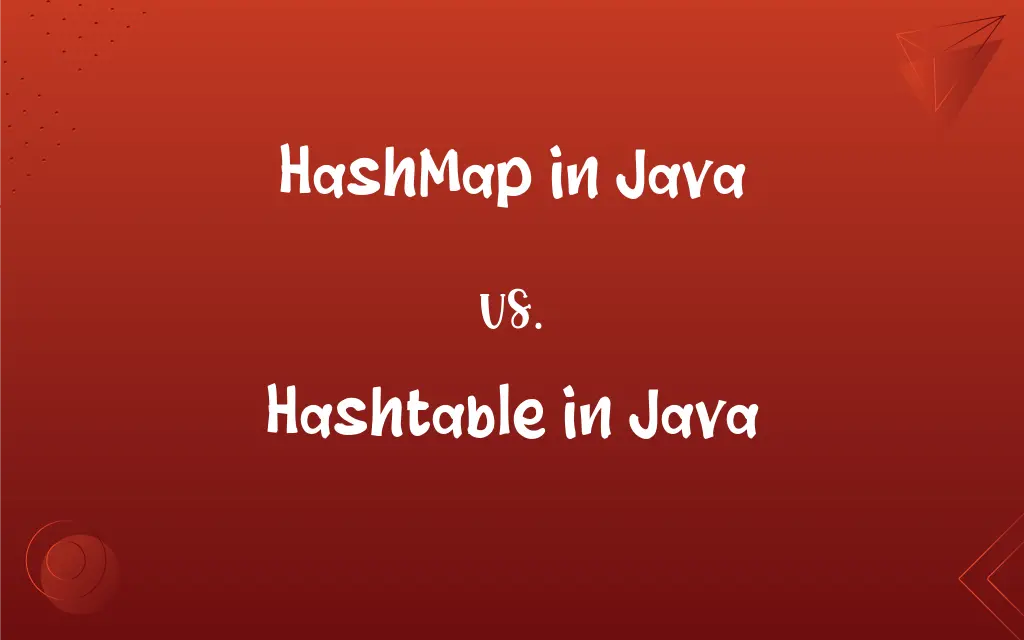HashMap in Java vs. Hashtable in Java: What's the Difference?
Edited by Aimie Carlson || By Janet White || Published on February 26, 2024
In Java, HashMap is a non-synchronized, unordered collection allowing null keys and values, while Hashtable is synchronized and doesn't permit nulls.

Key Differences
HashMap in Java is a part of the Collections framework, which allows storing key-value pairs. It permits one null key and multiple null values and does not maintain any order of its elements. Hashtable, another way to store key-value pairs, is a legacy class that is synchronized, meaning it is thread-safe. Unlike HashMap, Hashtable doesn't allow any null key or null values and maintains elements in a random order.
The non-synchronized nature of HashMap makes it unsuitable for multi-threaded environments where it might be accessed by multiple threads simultaneously. In contrast, Hashtable is synchronized, making it thread-safe, but this also means it has a performance cost due to the overhead of synchronization.
HashMap provides better performance in scenarios where thread synchronization is not needed. This is because the lack of synchronization avoids unnecessary overhead. On the other hand, Hashtable is a better choice in a multi-threaded environment where thread safety is a concern, but with the caveat of reduced performance.
HashMap is a part of the java.util package and is more commonly used in modern Java applications due to its efficiency and flexibility. Hashtable, being older and part of the original Java 1.0, is considered somewhat outdated and less efficient, especially in single-threaded scenarios.
Iterating over HashMap can lead to unpredictable order due to its hashing mechanism. Hashtable also uses hashing, but it ensures that no null keys or values are stored, which can be important in applications where null values are not acceptable or might lead to confusion.
ADVERTISEMENT
Comparison Chart
Synchronization
Non-synchronized (not thread-safe)
Synchronized (thread-safe)
Null keys and values
Allows one null key and multiple null values
Does not allow null keys or null values
Order of elements
Unordered
Maintains elements in a random order
Performance
Generally faster due to no synchronization
Slower due to synchronization
Usage
Preferred in non-threaded or single-threaded applications
Used in multi-threaded applications needing synchronization
ADVERTISEMENT
HashMap in Java and Hashtable in Java Definitions
HashMap in Java
HashMap does not maintain any order of its elements.
While iterating over the HashMap, we noticed the elements were in no specific order.
Hashtable in Java
Hashtable is a Java collection that stores key-value pairs in a synchronized manner.
For our multi-threaded application, we used Hashtable to ensure thread safety.
HashMap in Java
HashMap allows one null key and multiple null values.
The HashMap in our application stores various settings, with a null key representing the default setting.
Hashtable in Java
Hashtable does not allow any null key or null values.
While using Hashtable, we had to ensure that no null values were inserted.
HashMap in Java
HashMap is a Java collection used for storing key-value pairs in an unordered manner.
We used a HashMap to store user preferences because it allows quick retrieval.
Hashtable in Java
Hashtable is slower than HashMap due to its synchronized nature.
We noticed a performance dip when using Hashtable, due to its synchronization.
HashMap in Java
HashMap is not synchronized, making it unsuitable for multi-threaded environments.
In our single-threaded application, we utilized HashMap for its non-synchronized nature.
Hashtable in Java
Hashtable is part of the original Java 1.0 and is synchronized for thread safety.
Our legacy system uses Hashtable due to its presence in Java since the beginning.
HashMap in Java
HashMap is part of the java.util package and is widely used for its efficiency.
For our latest project, we chose HashMap over Hashtable for better performance.
Hashtable in Java
Hashtable maintains its elements in a random order.
The elements in the Hashtable were not in the order we inserted them.
FAQs
What is HashMap in Java?
HashMap is a collection in Java used to store key-value pairs in an unordered format.
Is Hashtable synchronized?
Yes, Hashtable is synchronized and thus thread-safe.
Can HashMap store null values?
Yes, HashMap can store one null key and multiple null values.
What is Hashtable in Java?
Hashtable is a synchronized collection in Java, storing key-value pairs in a thread-safe manner.
Is HashMap suitable for multi-threaded environments?
No, HashMap is not suitable for multi-threaded environments as it is not synchronized.
Why is Hashtable considered outdated?
Hashtable is considered outdated due to its slower performance and the availability of better alternatives like ConcurrentHashMap for thread safety.
Does HashMap maintain the order of elements?
No, HashMap does not maintain any specific order of its elements.
Which is faster, HashMap or Hashtable?
HashMap is generally faster than Hashtable due to the lack of synchronization.
Can Hashtable store null keys or values?
No, Hashtable does not allow any null keys or null values.
Can I replace Hashtable with HashMap?
Yes, but if thread safety is a concern, consider using ConcurrentHashMap instead.
Are there any concurrent versions of HashMap?
Yes, ConcurrentHashMap is a concurrent version of HashMap.
Can I iterate over a HashMap?
Yes, you can iterate over a HashMap, but the order of iteration is unpredictable.
What package does HashMap belong to?
HashMap belongs to the java.util package.
Should I use Hashtable in a new Java application?
Generally, ConcurrentHashMap is preferred over Hashtable in modern Java applications for thread-safe operations.
Is Hashtable part of Java's Collections Framework?
Yes, Hashtable is part of Java's Collections Framework, but it predates the modern collections.
Can Hashtable elements be ordered?
No, elements in a Hashtable are maintained in a random order.
What's a good alternative to Hashtable in Java?
ConcurrentHashMap is a good alternative, offering better performance with thread safety.
How does HashMap handle collisions?
HashMap handles collisions using a linked list or a tree structure in case of many collisions.
How do I choose between HashMap and Hashtable?
Choose HashMap for non-synchronized, faster operations, and Hashtable or ConcurrentHashMap for thread-safe operations.
Is there a performance difference between iterating over HashMap and Hashtable?
The performance difference is negligible in iteration, but HashMap may have a slight edge due to its non-synchronized nature.
About Author
Written by
Janet WhiteJanet White has been an esteemed writer and blogger for Difference Wiki. Holding a Master's degree in Science and Medical Journalism from the prestigious Boston University, she has consistently demonstrated her expertise and passion for her field. When she's not immersed in her work, Janet relishes her time exercising, delving into a good book, and cherishing moments with friends and family.
Edited by
Aimie CarlsonAimie Carlson, holding a master's degree in English literature, is a fervent English language enthusiast. She lends her writing talents to Difference Wiki, a prominent website that specializes in comparisons, offering readers insightful analyses that both captivate and inform.
































































